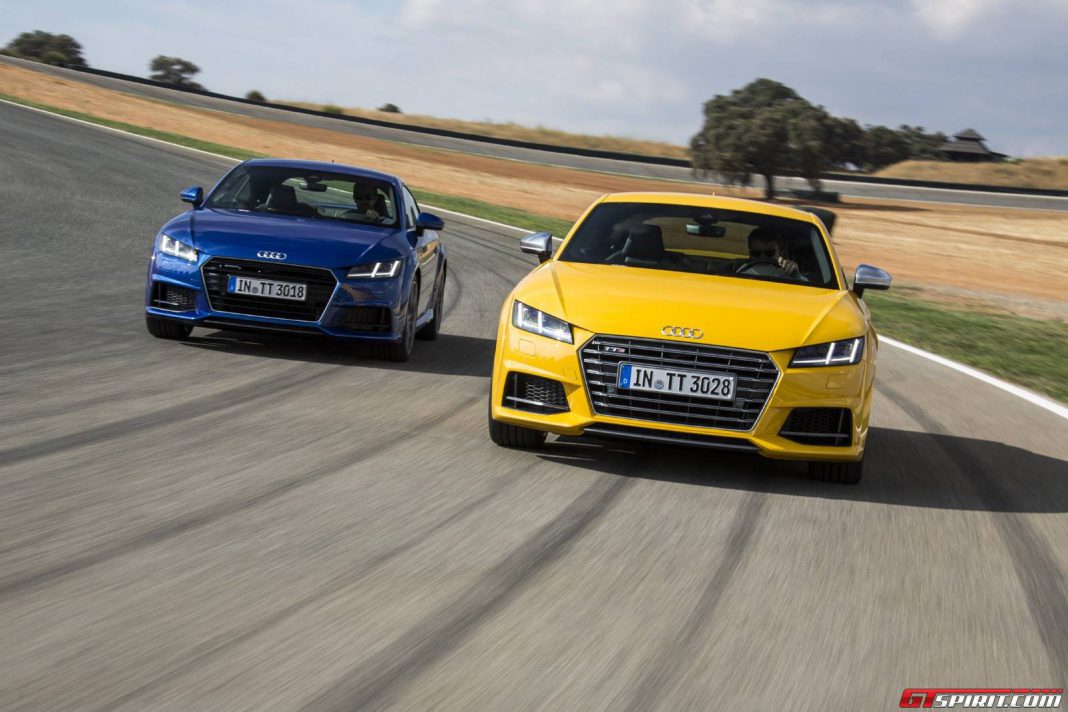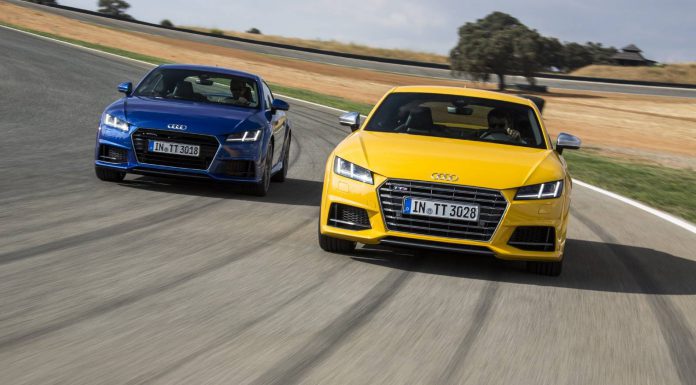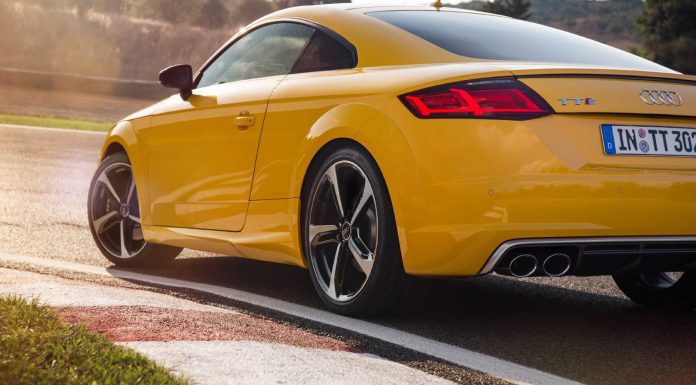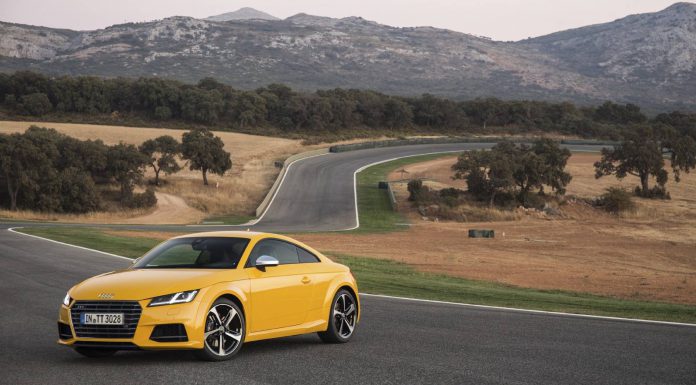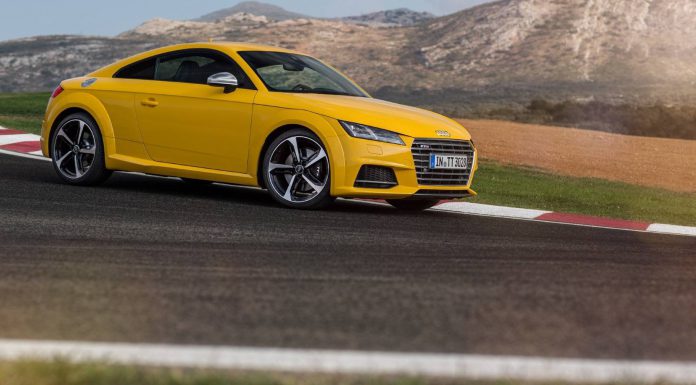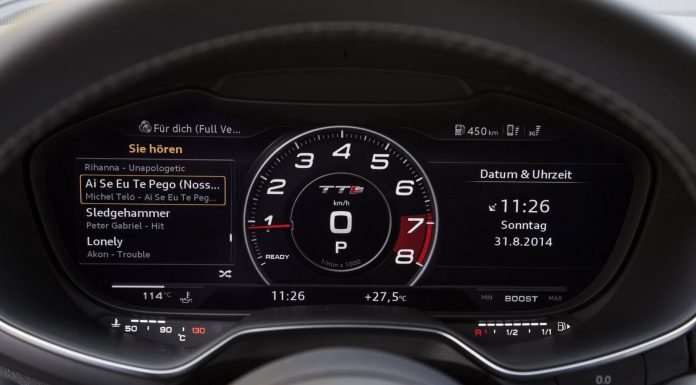16 years after the introduction of the first Audi TT, Audi strikes again with the launch of the third generation Audi TT. A compact premium sports car that created a segment in the last decade of the twentieth century.
With the TTRS model of the last generation still fresh in our memory we flew out to Spain to review the 2015 Audi TT and in particular the potent Audi TTS model. Audi’s goal was to make the new TT sportier and more innovative than its predecessor without losing the distinct looks and qualities of the Audi TT. Keep reading to find out if Audi accomplished their mission but before we will answer that we will talk you to some of the key characteristics of the new Audi TT.
Engine
The 2015 Audi TT comes with three different engine configurations. One TDI diesel engine and a TFSI petrol engine in the TT and a TFSI petrol engine in the TTS. Outputs of these newly developed fourcylinder engines lie between 184hp and 310hp. The 2.0 TDI offers 184hp and 380Nm of torque available between 1,750 and 3,250 RPM. This TDI engine is one of Audi’s clean diesel engines and emits only 110 grams of CO2 and has an average fuel consumption of 4.2 liters per 100 kilometers. The 2.0 TDI is only available with front-wheel drive and a six speed manual transmission.
The 2.0 TFSI in the 2015 Audi TT delivers 230hp and produces 370 Nm of torque between 1,600 and 4,300 rpm. The fuel consumption and CO2 emissions depend on the configuration and lie between 5.9 and 6.4 liters per 100 kilometers and 137 and 149 grams of CO2 for manual with frontwheel drive / S tronic with quattro.
The 2.0 TFSI in the 2015 Audi TTS delivers 310hp and produces 380 Nm of torque between 1,800 and 5,700 RPM. The large turbocharger runs up to 1.2 bar pressure and its temperature is reduced by a highperformance airtoair intercooler. Fuel consumption is listed at 6.8 liters per 100 kilometers and CO2 emissions of the S Tronic equipped TTS are 157 grams per kilometer.
Performance
The new Audi TT has segment worthy performance with sprints from 0100 km/h of 4.6 seconds for the S Tronic TTS. 0100 km/h takes 6.0 seconds for the manual frontwheel drive TT with 2.0 TFSI engine and 7.1 seconds for the TDI version. Topspeed is limited to 250 km/h for the both petrol engines and 241 km/h for the TDI.
Gearbox
As standard the 2015 Audi TT and Audi TTS come with a six speed manual gearbox that features a lightweight magnesium housing. The two TFSI engines in the TT and TTS are optionally available with a sixspeed S tronic double clutch gearbox.. As with the manual transmission, its internal gearing features sportily short ratios. The tall top gear helps reduce fuel consumption.
Our test car came equipped with the sixspeed Stronic double clutch gearbox. And although the gear changes happen swiftly as you might expect from a double clutch gearbox, it did leave some to be desired. In a world where 7speed is the standard and new generations of eight and even nine speed automatic gearboxes push efficiency and sportiness to new levels, the TT’s gearbox leaves some to be desired.
Chassis and Suspension
The Audi TT and TTS feature a McPherson front suspension. Aluminum components reduce the weight of the unsprung masses. The rack of the standard progressive steering is designed such that the ratio becomes more direct with increasing steering input. The fourlink rear suspension can process the longitudinal and transverse forces separately.
With its elaborate chassis and firm setup, the new Audi TT offers dynamic, highly precise handling. If the customer chooses the TTS, the S line sport package or Audi magnetic ride, the body is lowered ten millimeters. The TT 2.0 TFSI and the 2.0 TDI roll on 17inch wheels, each of which weighs only 8.7 kilograms, and 225/50 tires. The TTS comes with 18inch wheels and 245/40 tires. The Audi TTS has a comfort and dynamic setting for the suspension. And although you can clearly feel the difference between comfort and the sporty dynamic mode, small bumps are also felt in comfort mode.
Design
The design was particular important for Audi in the development of the new TT. Described as an design icon, the first generation Audi TT paved the way for three generations of a sporty yet compact – coupe / roadster. The third generation maintained largely the same dimensions as its predecessor. The key change is the increased wheel base that leads to smaller overhangs front and back and improved handling.
The front features a completely new nose with a large single grill and LED headlights that bear resemblance with the latest Audi Le Mans racer. In the rear a spoiler hides in the boot lid and expands at motorway speeds. The 2015 Audi TT has two large exhaust pipes located closer to the center. The TTS can be recognized by four tailpipes located on the far side of a rear diffusor.
Interior
The interior features the all new central cockpit concept featuring Audi’s new virtual cockpit. It is a major change and revolution with previous Audi interiors. First seen in the Lamborghini Huracan, Audi’s virutal cockpit is based on a new driver oriented infotainment and digital instrument system that will be used throughout the Volkswagen Group.
Audi took this new system further and redeveloped the entire dashboard and center console. All control elements are grouped around the driver and the climate control elements have been incorporated in the signature round air vents. Inside is plenty of space and for tall people don’t be surprised to find more leg space in the TT than in the current R8 or Lamborghini Huracan. The seats offer plenty of support but the onesizefitall sport seats are too small for taller drivers, instead opt for the standard seats which offer more adjustments.
Audi Virtual Cockpit
The Audi virtual cockpit is a major game changer for Audi and for the sportscar segment in general so it deserves a bit more explaining. It is a digital instrument cluster with highly adjustable graphics and it replaces the analog instruments and MMI monitor in the new TT. The driver can switch the 12.3inch, alldigital display between two different view modes.
The classic configuration features the speedometer and the tachometer in the foreground. In Infotainment mode, aspects such as the navigation map move to the forefront and the instrument dials are shown smaller. The TTS includes a third view that clearly illustrates the close ties to racing and places the tachometer front and center, enabling this view is a bit of a puzzle though.
With the Audi Virtual Cockpit, Audi also updated the MMI control elements and now has just six physical buttons. The number of different MMI control setups in the Audi range makes it even hard for a seasoned Audi driver to find its way around the systems. In combination with MMI navigation plus, it includes the MMI smart touch wheel – the touchpad on the top of the rotary pushbutton – with which the driver can do such things as zoom on the navigation map and enter characters. The menu structure was inspired by a smartphone and includes a search function. All key functions can be reached with just a few clicks, and the buttons on the side provide access to intelligently linked functions and options.
Despite a few MMI control issues the Audi Virtual Cockpit is very easy to use and additional information via Audi Connect – like departure times of flights at the nearest airport are very easy to call up to the display. The Google Maps navigation with satellite view is a nice gimmick but its reliability depends highly on the network coverage. In a driver oriented car like the Audi TT it is a major step forward. It remains to be seen how well the system is received in a family oriented car where the passengers also use the central screen for music selection and checking the map.
Driving Experience
For our Audi TT driving experience we exclusively reviewed the 2015 Audi TTS model with the turbocharged four cyclinder 2.0 TFSI engine that produces 310hp. Our particular car also came with Quattro allwheel drive and the sixspeed double clutch automatic gearbox. The fiery yellow color gives the Audi TTS a bright appearance and the new design is unmistakably recognized as the latest TT. Personal favorite on the outside is the signature aluminium fuel flap that reads TT. Underneath it you can insert the fuel nozzle directly into the tank neck without removing any cap, just like with a race car.
Every Audi TT comes with a comfort key that enables keyless entry and allows you to start the TT using the start/stop button in the center console. If you are familiar with Audi it comes as no surprise that the Dynamic Select button gives access to the key driver profiles from comfort to dynamic including an individual profile where you can configure your own favorite setup –including level of performance, damping, sound and steering.
We hit the start button and the four cylinder engine comes to life. Don’t expect any major fireworks like the Audi R8 but a sophisticated puff and light breathing from the exhaust. Our first stop of our journey is the Ascari race track in the mountains above Marbella. From Marbella up to Ronda leads us along one of our favorite roads in the world with an endless combination of bends. It soon becomes clear that the Audi TT comes with nearly every modern infotainment feature you can wish for, from mobile connectivity to audio streaming and additional Audi connect features.
Enough to keep us entertained until we reach the outskirts of town. We switch from comfort to dynamic and see what the little engine is capable of. It responds to the throttle very well and every upshift is greeted with a loud *duff* from the exhaust. The way the engine behaves and sounds reminds us strongly of the 2.0 liter turbo fourcylinder in the A45 /CLA 45 AMG. Although the AMG engine is more powerful with 360hp, this is compensated in the TTS by less weight.
Steering in the Audi TT is quite sporty, although not as sporty or direct as our favorite hot hatch of this year: the Audi S1. In that extend the Audi TTS is a tad more comfortable trying to appeal to a broader customer base, something we would love to see differently in a TTRS version of the new TT.
At Ascari the TTS feels at home, its nimble and easy to put through its paces at the race track. Thanks to the reconfigured Quattro system and the larger wheel base it has become much more dynamic than its predecessor. Understeer is reduced but not eliminated. The cars low weight is a benefit in absolute lap times and performance but the frontend feels a bit light under hard acceleration and the straight line braking stability is not as great as with some competitors.
On the way back to Marbella we had our favorite road nearly to ourselves. A road that we previously drove with a McLaren 12C Spider – a car that could hit triple the speed limit between corners easily. Exactly for that reason the Audi TTS was almost more enjoyable as you can have a lot of fun with it without breaking the law (too much). With Marbella back in sight there is one feature left to test: Launch Control! Instead of a flashy launch control button there is an entire procedure to engage launch control in the 2015 Audi TT.
Before you can put your foot down and release the brake you first have to switch the start/stop system off. Then engage dynamic mode, tick the ESC button briefly to engage ESC Sport. Now set the gearbox to S by pulling the gear lever down. Last hit the brake paddle hard for 1 second and hit the throttle until it holds 4,000 RPM. Release the brakes and off you go! The sensation is not the same as in a supercar – but we still had fun propelling the TTS from standstill to 100 km/h in 4.6 seconds.
Despite all the fun we had we also discovered a flaws. The brakes are prone to fading, even after four or five corners the paddle becomes much softer and if you don’t back down quickly overheat. And although Audi stressed the new TT comes with newly developed brakes, we had a similar experience with the Audi S3 Sedan recently.
A small flaw that has major impact or taller drivers is the seatbelt which is not height adjustable and therefor cuts in your shoulder while driving. Especially as the dynamics and gforces rose during our drive back from Ascari the seatbelt cut deeper into our shoulder. Another interesting discovery was the availability of lane assist as an option but unavailability of adaptive cruise control. Instead only regular cruise control is available. For a daily driver this is an option we would really miss.
Conclusion
The third generation Audi TT opens a new promising chapter. Our driving experience proved the TTS is at home on both the race track as the twisty roads in the Spanish country side. Its interior with Audi Virtual Cockpit is refreshing and a showcase of the future today. As a daily driver it offers a decent compromise between comfort and performance and has decent interior and luggage space too, we certainly can’t wait for a TT-RS model!

